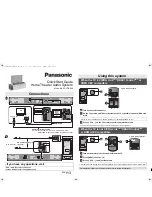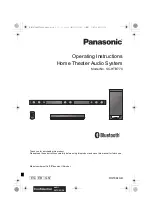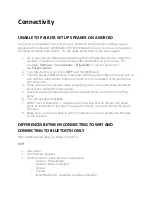
5
Viewed from the back the professional grade Dinkle plug for the Eyris rear speaker
connection panel has clear polarity markings. The left hand pair of + and - terminals
connect to the rear output terminals (+ and -) of your A/V amplifier. The right hand pair
of + and - connectors on the Dinkle plug enable direct connection, in series, to an
additional speaker.
Check cable and connection polarity to ensure correct phase.
WARNING
: EACH TIME ANOTHER SPEAKER IS ADDED IN SERIES TO A SINGLE AMPLIFIER
OUTPUT THE IMPEDANCE OFFERED TO THAT AMPLIFIER IS HALVED. CHECK THE
SPECIFICATIONS OF YOUR AMPLIFIER TO ENSURE THAT OUTPUT STAGE WILL REMAIN
STABLE INTO A LOAD OF 4 OHMS OR LESS.
INSTALLATION
To avoid potential damage to your loudspeaker, ensure that the amplifier is switched OFF
prior to connecting or disconnecting any cables. Before switching on double check that
all connections are secure and that polarity is correct.
CONNECTION IN SINGLE WIRE MODE
(See fig. 3)
Connect the pair of link cables supplied in the accessory kit to each loudspeaker terminal
panel as follows:
• Starting with the red (positive) lead fit this into the red (positive) low frequency (LF)
terminal on the loudspeaker. To do this, loosen the terminal nut sufficiently to allow
insertion of the spade connector and then re-tighten the terminal nut finger-tight.
• The spade connection at the other end of the lead should be connected to the red
(positive) high frequency (HF) terminal on the loudspeaker.
• Repeat this operation for the black (negative) HF and LF terminals
• Repeat the whole operation for the other loudspeaker
For optimum performance in single wire mode, loudspeaker cable connections from the
amplifier should now be made to the high frequency (HF) terminals of the loudspeaker:
• The positive (plus) terminal on the amplifier left channel ( or coloured red)
must be connected to the positive HF terminal on the left speaker. The left speaker is
the one on the left as you look at the stereo pair from your listening position.
• The negative (minus) terminal on the amplifier left channel (marked - or coloured
black) must be connected to the negative HF terminal on the left speaker.
• Repeat this connection process for the right speaker. Remember that the positive (+
or red) on the amplifier must be connected to the positive (+ or red) on the speaker
and the negative (- or black) to negative.
Select a signal source, such as a CD player; switch on the amplifier and slowly turn up
the volume control to check that both loudspeakers are reproducing bass and treble
information.
CONNECTION IN BI-WIRE MODE
(See fig. 4)
Please note in bi-wire mode that the link leads, which are supplied in the accessory pack,
should NOT be fitted.
• Be sure that the amplifier is switched OFF and then prepare the two sets of cabling
for each 'side' of the system separately. Measure and cut four lengths of cable, two per
speaker.
Label two of the cable lengths Left LF and Left HF (low frequency and high frequency)
then repeat this process for the right pair.






























